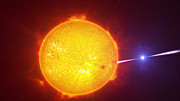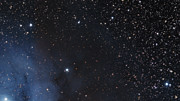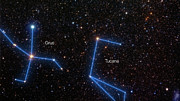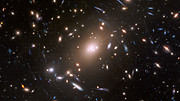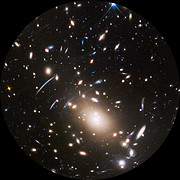Fig.1: Eye of Horus in pseudo color. Enlarged image to the right (field of view of 23 arcseconds x 19 arcseconds) show two arcs/rings with different colors. The inner arc has a reddish hue, while the outer arc has a blue tint. There are also the lensed images of the background galaxies which are originally the same galaxies as the inner and the outer arcs. The yellow-ish object at the center is a massive galaxy at z = 0.79 (distance 7 billion light years), which bends the light from the two background galaxies. (Credit: NAOJ)
Fig. 2: A schematic diagram showing the location of galaxies creating the gravitational lens effect of Eye of Horus. A galaxy at 7 billion light years from the Earth bends the light from the two galaxies behind it, one at 9 billion light years, and the other at 10.5 billion light years. (Credit: NAOJ)
In a rare discovery, the National Astronomical Observatory of Japan (NAOJ) together with an international team of researchers from the University of Tokyo’s Graduate School of Science and the Institute of Advanced Studies’ Kavli Institute for the Physics and Mathematics of the Universe (Kavli IPMU) advanced knowledge of how light from a distant galaxy can be bent greatly by the gravitational effect of a foreground galaxy. The effect is known as strong gravitational lensing.
Usually, multiple lensed images of a single
background galaxy are seen. In theory, the foreground galaxy can lens
multiple background galaxies at the same time. The data showed a rare
gravitational lensing effect, which suggests lensing by a foreground
galaxy of two background galaxies at different distances (Fig. 1). Such
systems, called “Double Source Plane (DSP) Lenses,” offer unique
opportunities to examine the fundamental physics of galaxies while
extending our knowledge of cosmology.
Based on data from the Sloan Digital Sky Survey,
the lensing galaxy has a spectroscopic redshift of z = 0.79 (or 7.0
billion light-years away, Note 1). Further observations of the lensed
objects using the infrared-sensitive FIRE spectrometer on the Magellan
Telescope confirmed the existence of two galaxies behind the lens—one at
z = 1.30 and the other at z = 1.99 (9.0 and 10.5 billion light-years
away, respectively). This is the first DSP lens for which the distances
to all the three galaxies are known accurately, which enables more
accurate understanding of the mass distribution of the foreground
galaxy.
Researchers and undergraduates made the discovery
while visually inspecting images at the NOAJ headquarters in Mitaka,
Tokyo as part of a Subaru Telescope invitation for students in September
2015. The images were gathered from the Subaru Telescope’s Hyper
Suprime-Cam (HSC), which is mounted in Hawaii. Japan is conducting a
widespread survey with the HSC of large areas of the sky at an
unprecedented depth as part of the Subaru Strategic Program.
“When I was looking at HSC images with the
students, we came across a ring-like galaxy and we immediately
recognized it as a strong lens system-lens,” said lead author of the
paper Masayuki Tanaka. “The discovery would not have been possible
without the large survey data to find such a rare object, as well as the
deep, high quality images to detect light from distant objects.”
The rare finding has been dubbed the “Eye of
Horus” because of its eye-like appearance (including bright knots, an
arc, and a complete Einstein ring), which is due to an alignment of the
central lens galaxy and both sources, and resembles the eye of Horus,
the ancient Egyptian sky god. The survey expects to find 10 more systems
of the same kind.
“With the HSC survey, we expect to find about 10
DSP lens systems, providing new insights in the physics of galaxies and
the expansion of the universe over the last several billion years,” said
Anupreeta More, a researcher at the Kavli IPMU and a co-author of the
paper.
Researchers involved in the discovery include
Kavli IPMU Project Researcher Anupreeta More and Project Researcher
Alessandro Sonnenfeld as well as Associate Scientist Masamune Oguri, who
is also affiliated to the University of Tokyo Graduate School of
Science, Department of Physics.
Note:
1. Conversion of the distance from the redshift uses the following
cosmological parameters - H0=67.3km/s/Mpc, Ωm=0.315, Λ=0.685, based on
Planck 2013 Results.
For more information, please see the press release of the National Astronomical Observatory of Japan Hawaii Observation.
Paper Details:
Journal:
The Astrophysical Journal Letters (ApJ, 826, L19)
Title:
A Spectroscopically Confirmed Double Source Plane Lens System in the Hyper Suprime-Cam Subaru Strategic Program
DOI: 10.3847/2041-8205/826/2/L19 (2016/7/25)
Authors and Affiliations:
Masayuki Tanaka, National Astronomical Observatory of Japan, Japan
Kenneth Wong, National Astronomical Observatory of Japan, Japan
Anupreeta More, Kavli Institute for the Physics and Mathematics of the
Universe (Kavli IPMU, WPI), University of Tokyo, Japan Arsha Dezuka,
Department of Astronomy, University of Kyoto, Japan Eiichi Egami,
Steward Observatory, University of Arizona, USA Masamune Oguri, Kavli
Institute for the Physics and Mathematics of the Universe (Kavli IPMU,
WPI), University of Tokyo, Japan; Department of Physics, University of
Tokyo, Japan; Research Center for the Early Universe, University of
Tokyo, Japan Sherry H. Suyu, Max Planck Institute for Astrophysics,
Germany; Institute of Astronomy and Astrophysics, Academia Sinica,
Taiwan Alessandro Sonnenfeld, Kavli Institute for the Physics and
Mathematics of the Universe (Kavli IPMU, WPI), Universi-ty of Tokyo,
Japan Ryou Higuchi, Institute for Cosmic Ray Research, The University of
Tokyo, Japan Yutaka Komiyama, National Astronomical Observatory of
Japan, Japan Satoshi Miyazaki, National Astronomical Observatory of
Japan, Japan; SOKENDAI (The Graduate University for Ad-vanced Studies),
Japan Masafusa Onoue, SOKENDAI (The Graduate University for Advanced
Studies), Japan; National Astronomical Obser-vatory of Japan, Japan
Shuri Oyamada, Japan Women’s University, Japan Yousuke Utsumi, Hiroshima
Astrophysical Science Center, Hiroshima University, Japan.
Paper abstract:
The Astrophysical Journal Letters
arXiv.org: Pre-print
Contact:
John Amari
Press Office
Kavli Institute for the Physics and Mathematics of the Universe
Institutes for Advanced Study
The University of Tokyo
TEL: +81-04-7136-5980
E-mail: press@ipmu.jp
The University of Tokyo, Institutes for Advanced Study







